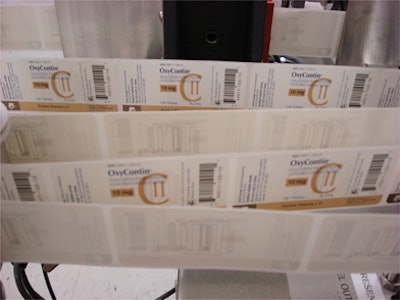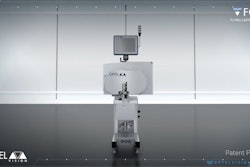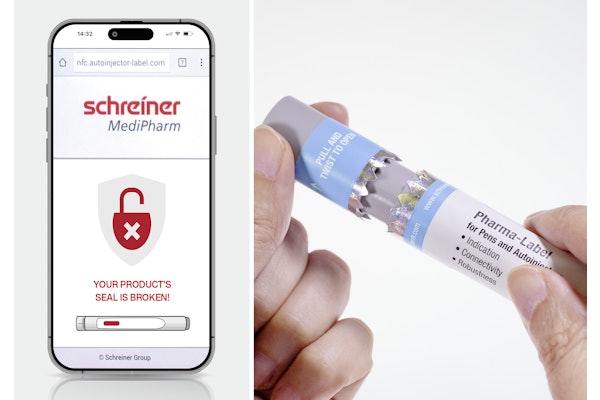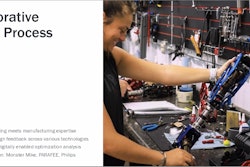
"In trying to get an RFID program off the ground, you're working with an emerging technology, so you want to go in step-wise fashion, with buy-ins from many cross-functional project teams in your company," said Mike Celentano, associate director of supply chain systems and RFID for Stamford, CT-based Purdue Pharma. "There's also off-site testing and considerable concept work." Celentano credited this steering-by-committee approach for the initial success of the company' RFID program, when he spoke in a presentation at the recent Brand-Protection Packaging Forum . Celentano and Aaron Graham, Purdue Pharma's chief security officer, delivered a co-presentation, "The Case for RFID: Is it an Authentication Solution or a Track-And-Trace Tool?"
The company's RFID program aims to address patient safety by combating counterfeiting. "The problem of counterfeiting has gotten so out of hand that China executed the head of its FDA," said Graham. "From our manufacturer's perspective, public health is the issue-patient safety and brand integrity--so we use packaging and RFID as a way to address the problem through serialization and track-and-trace technology."
Graham, a former undercover narcotics agent for the Drug Enforcement Agency, delivered a dramatic presentation, complete with video that touched on some of the global horror stories about counterfeit drugs. "The point I want to make is when a person takes a pill in the safety of his or her home, is he or she really assured that the drug is authentic? I think the answer is no," he said.
Counterfeit products and packaging often look so much like authentic versions that it can be difficult for experts to tell the difference, much less consumers. Adding to the difficulty is the distribution chain, Graham explained, where the bad guys can become an authorized distributor of record (ADR), allowing them to buy and sell products legally, even though their intent is to divert them. "If you're an ADR, you can say you bought drugs directly from the manufacturer and start a new paper pedigree. The Prescription Drug Marketing Act of 1988 has a loophole big enough to drive a truck through," said Graham, regarding secondary wholesaling.
Purdue Pharma has invested years of research and considerable finances into making sure that its packaged drugs can be tracked and traced throughout the pharmaceutical distribution chain.
RFID-enabled packaging
By establishing an electronic rather than a paper pedigree, says Celentano, a packaged product becomes difficult to counterfeit. "RFID and product serialization can make a difference," he says. He made the following points during the BPPF presentation:
• The pharmaceutical industry is being compelled by regulatory drivers at both the state and federal levels to move toward serialization at the smallest saleable package.
• We're not really being told how to serialize, what numbering to use, or to use bar coding or RFID, as long as we're moving toward a serialization platform. I think the pharmaceutical industry is quickly moving to a standards-based technology that will be meaningful to everyone in the supply chain. The Serialized Global Trade Identification Number [SGTIN] is a standard that comes out of the GS1 EPC Global organization, an industry standards body that's vertical in nature, but has a pharmaceutical and life sciences branch. We're trying to capitalize on the standards from that body so that we're moving together toward a solution.
• Companies face a tremendous amount of financial exposure with product in the gray market, where there may be hundreds of millions of dollars being washed through the distribution system.
• We embarked on our first RFID tagging initiative in 2004, largely in response to a Wal-Mart mandate. They placed an onus on their major consumer packaged goods suppliers to get involved with RFID. Much less publicly, they also approached their controlled-substance pharmaceutical suppliers, of which we were a major one, to start item-level RFID tagging.
• A year later, we manufactured our first batch of RFID-tagged OxyContin, using UHF Generation 1, Class 0 tags. We engaged in pedigree pilot programs with some of our downstream partners to create a chain-of-command record as product moves through the supply chain. What I like about the convergence of RFID, product serialization, and pedigree is the opportunity to move packaging data and electronic information downstream. We see that comprehensive approach with the industry and with the influence of state and federal drivers as things that will take the issue forward on a holistic level.
• In June, 2006, we moved to UHF Generation 2 RFID technology, adding case-level tagging capability, and targeting all domestic bottles and cases of our OxyContin product, and collecting and aggregating the tag data from item to case to pallet. In terms of building a pedigree, that's seen as part and parcel of your requirement as a manufacturer or repackager, that you're going to have to [track] your smallest unit of sale-bottles, in our instance-in the distribution environment.
• In June 2007, we started manufacturing and shipping UHF Gen 2-tagged product, 1.3 million bottles' worth. By now, we've passed the two million mark on OxyContin. We are collecting data relationships on item-level tags and serialized cases as they come off the packaging line.
• We have our tags pre-encoded by a label converter, which means we are not managing the serial numbers or writing RFID tags in-house. That's just a choice we made because we didn't view it as a core competency. It's working well for us. We do, however, employ serial numbers on cases in-line.
• The date for e-pedigree implementation in California has been moved back to 2011, and it will be a major undertaking. Major trading partners along the chain will need to communicate and develop a numbering system that works for everyone involved.
Addressing RFID challenges
With Purdue now having more than a year of actual packaging line experience using RFID, Celentano commented on the following key areas of concern:
• Tag supply. "So far, so good. Gen 2 technology means the process for making the tags has been simplified and made more robust. We no longer have the availability and lead-time problems we had with the first round of RFID technology."
• Reliability. "The tags are surviving the rigors of packaging."
• Interoperability. "We see a good degree of interoperability between the readers and tags based on the UHF Gen 2 standard. What you need to build a critical mass solution is a standards-based system."
• Multisourcing. "We're not quite there yet at the item level. We're single-sourcing our tags, so there's a little vulnerability there for us now, but I expect we'll be moving to a backup tag supply soon."
• Cycle times. "Can we sustain packaging and distribution center cycle times? We experienced some degredation early on, which was centered mostly around rework. But it's vastly improved after the first couple of months following some tweaking. It's no longer a capacity restraint for us. We're running where we need to be in our distribution center and on our packaging line."
Future plans
Celentano says, "We are now trying to build our pedigree platform on top of the serialization data-carrier concept we have in place. We have a way to extract data and send it to our downstream channel partners in an interoperable fashion. That's where we're going."
Graham provides an overall perspective: "We manufacture a product, and put an electronic code on it that serves as a unique indentifier. We ship it to the wholesaler after we send them an advance shipping notice. There is a digital signature so it can electronically indicate that it has received the product. There is no paper pedigree that can be torn up, with a new one started. At each step, there's an electronic or digital signature. That allows us to take the secondary wholesaler or diverter out of the equation. This technology prevents the introduction of counterfeit goods into legitimate commerce, and that's the objective a pedigree and track-and-trace technology."
Purdue's packaging line process
At Purdue Pharma's manufacturing and distribution facility in Wilson, NC, RFID is employed on one packaging line for bottles of the company's OxyContin (oxycodone HCl controlled release) tablets. Used for the management of moderate to severe pain, OxyContin is an opioid agonist and a Schedule II controlled substance with an abuse liability similar to morphine.
Celentano explained to the Brand-Protection Packaging Forum audience that the line runs 100 to 110 bottles/min. As bottles are conveyed, the RFID wraparound paper labels are applied much like any label. An in-line reader checks to make sure the RFID tag in the label is readable and that the tag matches the fixed portion of the serial number. The fixed portion of the number carries information about the drug, serving as the National Drug Code, Celentano says. The variable portion of the serial number carries unique numbering. If either portion of the serial number doesn't check out properly, the bottle is rejected.
After labeling, OxyContin bottles are conveyed through a shrink wrapper and are wrapped in six-packs, with eight of these packs manually placed into a shipping case. The case is also RFID labeled. As the closed case conveys downstream, a machine reads 49 total tags, one for the case, and one for each of the 48 bottles. "At this point, we're making an association between the parent [case] and children [bottles], storing that in a database. That's what we call our commissioning event for the bottles, as they're being 'born' with a license plate," said Celentano.
He explained that each 1x1-in. RFID inlay consists of an antenna and a chip embedded into the back of each label. NJM/CLI supplied Purdue Pharma with the RFID-enabled case print-and-apply labeler, PLC software, and hardware assembly. Purdue Pharma is using Systech packaging execution software, Motorola antenna readers and RFID tags, Impinj packaging line readers and reader antennas, Zebra case labeling, coding, and printing equipment, with George Schmitt serving as the label converter.
"At this point, we've tagged more than two million bottles," said Celentano. "We're seeing performance rates of 99.983 percent in terms of tags that have performed post-packaging. One of the things I attribute that to is a good QA process at our label converter, which identifies and rejects any bad tags before we ever see them. The performance range is acceptable, but no bad tags go out the door. If an RFID tag doesn't read properly, it goes through a rework process so that 100 percent of the bottles go out with readable RFID tags."
Lessons learned
Purdue Pharma has learned several valuable lessons as it's proceeded with its RFID implementation. Here are two key lessons, as reported by Celentano:
• Vendor selection. "There are plenty of vendors out there making tags in various form factors. The same with equipment. We conducted preliminary qualification studies, tested our packaging, and ran it through both our labs and vendor labs to gather some readings on what our potential success might be. We narrowed the field, coordinated vendors for additional testing, and put together protocols. Ours was not an out-of-the-box solution."
• Label trials and tribulations. "We excitedly waited for our first set of RFID labels to arrive in our packaging department. It's not inexpensive to do this. When our engineers went to mount the labels on our labeling equipment, they noticed something funny-each label had a little perforation through the center of it where the RFID chip pushed through the paper label. It turned out the rollstock was wound too tight.
"The supplier backed down on the tensioner and sent us another set of label rollstock with the RFID tags embedded. This second set looked great, but as our engineer moved the web to the packaging line, the entire roll unwound like the world's largest paper telescope. That was two down. Like the story with the three bears, the third time the supplier got the web tensioning just right."
The bar-coding/RFID debate
During their Brand Protection Packaging Forum presentation, Graham and Celentano noted that Purdue Pharma is open to different technologies, including both RFID and bar coding.
"We had to make decisions early on at some risk as to choosing technologies that we felt the industry would accept," said Celentano. "We had some experience already because of the Wal-Mart initiative, so we decided to move forward with RFID, though we are looking at 2D bar coding as a redundant feature because a lot of our industry partners view it as a more reachable interim solution.
"We use Gen 2 RFID with OxyContin bottles and cases, and we use a linear bar code on pallets. We haven't seen interest at this point from our wholesaler partners to use RFID at the pallet level because pallets have little longevity. When the pallet arrives at a location, it's quickly broken down, so it's more important that cases and items are serialized with RFID tags.
"We're starting to see an acceptance and preference from our major wholesalers for an RFID-based solution. As a company moving thousands of cases of product through its doors every day, and tens of thousands of bottles, we prefer RFID." One key reason for the RFID preference, he says, "is because it doesn't require a line-of-sight technology."
[With RFID], "you remove that line-of-sight requirement and can read through sealed totes. And it doesn't matter which way cases are facing."





















